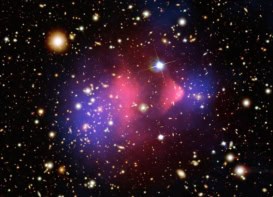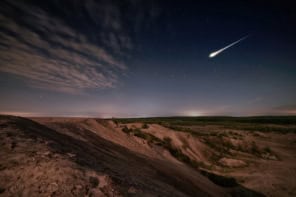Three independent teams of astronomers have released new and improved maps of where dark matter is lurking in parts of the universe. All three groups have charted the mysterious substance by looking at how its presence distorts the images of distant galaxies as their light travels to Earth. As well as providing further insights into dark matter, the studies could provide crucial information about another mysterious substance – dark energy.
About 95% of the mass/energy content of the universe is believed to comprise dark matter and dark energy – two substances about which physicists know very little. Dark matter cannot be observed directly but is believed to make up about 23% of the mass/energy in the universe. Its existence has been inferred from the gravitational tug that it exerts on visible matter such as galaxies. Dark energy, which is also invisible, is thought to account for about 72% of the mass/energy and its existence is inferred from the accelerating expansion of the universe.
Gravitational lensing
One team has used data from the Canada–France–Hawaii (CFHT) telescope to map the location of dark matter in four regions of the sky. The survey, known as CFHTLenS, includes about 10 million galaxies, which are all about six million light-years away. As the light from these galaxies travels to Earth, it is affected by the gravitational field of the dark matter that it passes along the way – a phenomenon called gravitational lensing. This distorts both the shape of the galaxies and their relative orientations as we see them on Earth – deviations that can be used to map the density of dark matter.
Observed over a period of five years, the four different patches of the sky were studied – each about 1° by 1° – using the MegaCam camera on the CFHT. The images cover a much larger area of the universe than a previous map produced by the team – which only covered 0.25° by 0.25°. The maps reveal that dark matter tends to clump around large clusters of galaxies – something that astronomers had expected but are unable to confirm in vast sections of the universe.
The team is now applying its analysis technique to data from the Very Large Telescope in Chile, which should result in much more of the sky being mapped. “Over the next three years we will image more than 10 times the area mapped by CFHTLenS, bringing us ever closer to our goal of understanding the mysterious dark side of the universe,” says team member Koen Kuijken of Leiden University in the Netherlands.
Shear brilliance
The other two dark-matter maps have been made by two independent groups, both of which claim to be the first to show that “cosmic shear” measurements can be unambiguously made by ground-based telescopes. Cosmic shear is a type of gravitational lensing that makes a distant object appear stretched – turning a circular image into an elliptical one, for example. By analysing the cosmic shear of images of distant galaxies collected over nine years by the Sloan Digital Sky Survey (SDSS), the teams were able to create dark-matter clumps.
The teams – one largely based at Fermilab and the other at the Lawrence Berkeley National Laboratory (LBNL) – have been able to improve their measurements by combining multiple snapshots of the same parts of the sky taken in the period 2000–2009. Known as “co-addition”, this process helps to reduce the effects of atmospheric distortion on the shear measurements and enhance the strength of signals from very distant and very faint galaxies.
The resulting dark-matter maps could be used to gain further insights into dark energy because dark energy should have an important effect on how dark matter is distributed in the universe – in particular how it tends to clump together.
“The community has been building towards cosmic-shear measurements for a number of years now,” says Eric Huff, who is a member of the LBNL team. “But there has also been some scepticism as to whether the measurements can be done accurately enough to constrain dark energy. Showing that we can achieve the required accuracy with these pathfinding studies is important for the next generation of large surveys.”



